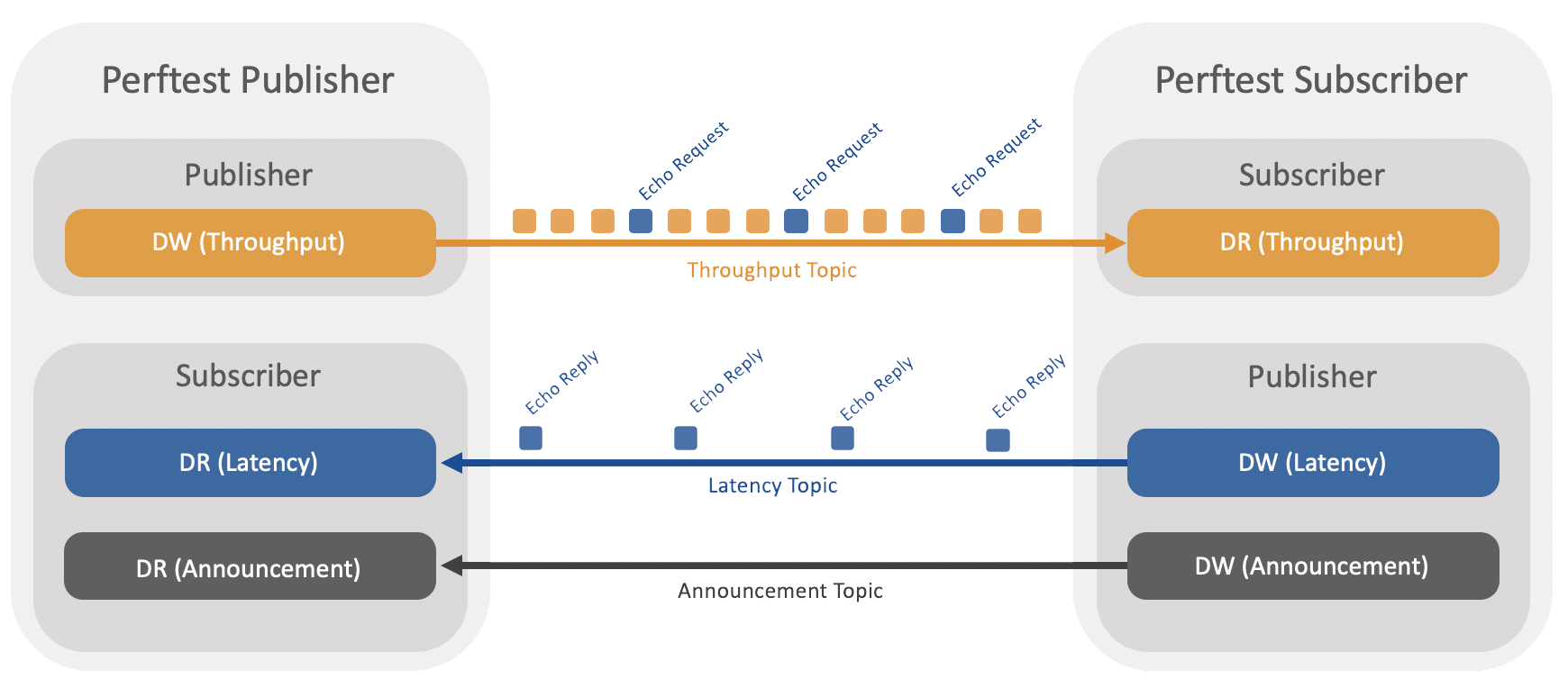1. Introduction
1.1. Testing Performance
This section describes the combined latency and throughput test application for RTI Connext DDS.
The test measures what is sometimes called loaded latency—latency at a given throughput level. It can help you answer questions such as:
For a given publishing configuration (e.g., queue size, batching settings), sample size, and subscribing configuration (e.g., queue size, Listener vs. WaitSet), what is the throughput of my network?
When my network is heavily loaded, what latency can I expect?
For a given configuration, what is the best-case latency with no other traffic on the network?
For examples of specific configurations, see Command-Line Parameters.
This performance test is implemented in C++ (Traditional and Modern APIs), C#, and Java.
Note
All references in this document to “C++” refer to both the Traditional and Modern C++ APIs, unless otherwise noted.
1.2. Middleware
RTI Perftest can be built against RTI Connext DDS Professional and RTI Connext DDS Micro 3.0.0 (also 2.4.11 with some limitations).
RTI Perftest can also be used to test raw UDPv4 or SHMEM performance.
To do this, RTI Perftest uses the RTI Connext DDS Professional internal
transport layer to interact with sockets. In this mode, RTI Perftest skips
the DDS protocol to directly send the data, which is serialized using the same
functions that RTI Connext DDS Professional uses.
1.3. Overview
The publishing side of the test writes data as fast as it can. Every few samples (configured through the command line), it sends a special sample requesting an echo from the subscribing side. It uses this "request -> echo" exchange to measure round-trip time (RTT) latency. One-way latency is calculated as RTT/2.

Perftest Overview Diagram
As you will see in Command-Line Parameters, there are many command-line options, including ones to designate whether the application will act as the publisher or subscriber.
You will start multiple copies of the application (typically one publisher and one or more subscribers):
The publishing application publishes throughput data; it also subscribes to the latency echoes.
The subscribing applications subscribe to the throughput data, in which the echo requests are embedded; they also publish the latency echoes.
The publisher prints the latency test results, and the subscriber prints the throughput results.
1.4. Latency Test vs. Throughput Test
RTI Perftest allows two operational modes: Throughput Test and Latency Test.
1.4.1. Throughput test
The throughput test is the default mode when RTI Perftest publisher and subscriber applications are started.
In this mode, the publisher side starts sending samples as fast
as possible. Once every latencyCount samples (which for a throughput
test is 10000 samples by default), RTI Perftest marks a sample to be answered
by the subscriber side. The answer is the exact same sample. The
round-trip time (RTT) is calculated from the time it took for the sample to be
sent, plus the time it took for the publisher to receive it.
Doing a throughput test provides the maximum throughput (Mbps) at which the publisher will be able to send samples to a subscriber. The latency obtained in this test will also be displayed by the publisher application; however, that latency is affected by the fact that the publisher and subscriber will be flooding the network and filling all their internal queues (sending and receiver queues, as well as the NIC queues). Therefore, to measure the pure latency in the best-case scenario, you should use the Latency Test mode.
1.4.2. Latency test
In this mode, the publisher side changes its behavior: every sample it sends
is marked as a latency sample (latencyCount is equal to 1 in this case).
The publisher also waits until the sample is sent back and received by the publisher
before sending the next sample (called "stop-and-wait" mode or
"ping-pong" mode).
In this way, the latency test mode is able to send samples, ensuring all the RTI Connext DDS queues are empty.
The only requirement to change the operation mode to do a latency test is to
provide the -latencyTest command-line parameter to the publisher side. See
Command-Line Parameters for more details.